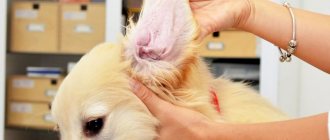Anyone who has a fur baby has wondered: why does the puppy urinate often? The fact is that he cannot control the process of urination. He doesn't know how to ask to go outside, and the result is constant puddles on the floor. But the older the baby gets, the less often such embarrassments occur.
It is believed that normally a three-month-old puppy should walk 10-12 times a day, a six-month-old puppy - up to 8 times, and a one-year-old puppy - 6-7 times a day. Additionally, your baby may leak urine whenever he is very excited or scared. The number of urinations of an adult dog is reduced to 3-4 times a day, and, in addition, it acquires the skill of asking to go outside or patiently waiting for a walk. But there are situations when the animal feels a constant urge to urinate. They are often so strong that the pet cannot wait. Why does this happen, is it normal or pathological, and what to do in this case? Our article will talk about this.
How does urination occur?
The process of urine formation begins in the kidneys, from where it flows through the ureters into the bladder, accumulating and stretching its walls. The muscle that expels urine (detrusor) is in a relaxed state at this moment, and a special valve, the sphincter, located at the beginning of the urethra, prevents urine from flowing out. When the pressure reaches its limit, receptors in the walls of the organ transmit a signal to the brain. The detrusor becomes tense, and the sphincter relaxes and urination occurs.
First aid
First of all, if you suspect a disease, you should seek advice from a veterinary clinic. It is worth providing the animal with a sufficient amount of fresh water. This is especially true in cases where the pet relieves itself in small portions, but often.
It is recommended to walk your dog more often. If the weather is bad outside, then you should do the toilet at home: lay out a diaper or show your pet a litter tray. This place should be warm and draft-free.
What not to do
You cannot treat an animal yourself. Especially with products from the first aid kit for people.
Even if it helped a friend's pet. Each animal has individual characteristics, and self-medication can only harm the dog.
Variant of the norm
The normal variant includes situations that do not require therapeutic measures. In some cases, the deviation can be corrected in other ways. There are three types of reasons why frequent urination occurs, related to the normal variant:
- natural;
- behavioral;
- age.
Natural causes
Natural reasons why a dog feels the urge very often can accompany both controlled and uncontrolled urinary incontinence. They are as follows:
- Severe stress that a dog receives as a result of excitement, fear, anxiety. To help an animal, you need to calm it down, create a friendly environment, and inject a sedative.
- Natural uncleanliness. The cause of incontinence can be poor upbringing, when the dog is not instilled with a conditioned reflex that it should urinate only on the street.
Behavioral reasons
If a dog pees often, then the causes of incontinence may be some features of the dog's behavior:
- The pet urinates to indicate its obedience to its owner or a stronger opponent. In such cases, she may fall on her back or sit on her paws. The owner needs to notice what exactly provokes the release of urine (eye contact, stern tone) and try to eliminate this factor.
- Marking the boundaries of your territory by leaving marks. In this case, the problem can only be solved by sterilization or castration of the animal.
- A dog may urinate in the house to spite its owner when he is dissatisfied or annoyed with something (jealousy, desire to avenge punishment, desire to attract attention, and so on). The owner needs to try to restore mutual understanding with his pet.
Typically, in the case of behavioral features, urine output is controlled by the dog.
Age reasons
Frequent urination in your dog may also be due to age-related reasons:
- Incontinence in an older dog. In older age, muscles gradually lose tone, the sphincter weakens and therefore involuntary urine leakage may occur. Correction of this disorder occurs through medication.
- Frequent urination in young females during estrus. Dogs that have not yet given birth experience quite severe pain at this time. To alleviate their condition, they are forced to empty their bladder frequently. To solve the problem, you need to walk the dog more often during such periods.
- Another reason for urinary incontinence in young bitches is the late formation of the hormonal system. Provoking factors can be different - lack of vitamins, poor nutrition, family history. Symptoms usually disappear after the first pregnancy.
Do age-related changes cause a puppy to urinate frequently (dog)
Of course, the changes that an animal’s body undergoes associated with age also affect its frequency of urges to the toilet. Because the older the pet becomes, the more its smooth muscles weaken. In this particular case, help will only be provided by treatment with special supportive agents, which can only be prescribed by a veterinarian.
If you encounter a similar problem, you can seek a full, detailed consultation with us at the veterinary center, where high-level specialists will literally explain to you the essence of the current situation, as well as ways to overcome it. And if you don’t have time, then just call the reception and call a veterinarian to your home. He will provide all the necessary documents plus licenses upon arrival.
Pay attention to your animal how much water it drinks per day, because another reason may be that the pet drinks too much water and then urinates too often. Also notice what color your animal’s urine is, because its transparency is the main indicator of whether your puppy is suffering from a disease such as cystitis.
- Signs of cystitis in a dog are as follows:
- the animal often urinates, although it does not drink liquids excessively, in small portions, and also whines;
- droplets of blood and/or pus are clearly visible in the urine;
- lethargy;
- refusal to eat;
- elevated body temperature.
If you notice at least a couple of the listed symptoms in your pet, immediately seek advice and treatment from a veterinarian. It's really not worth the wait.
Pathology
If your dog urinates frequently and a lot, you may need to talk about pathological urinary incontinence. It is divided into true and false:
- False incontinence is the involuntary leakage of urine in the presence of gross pathologies of the urethra, bladder or ureter.
- True incontinence is involuntary urination in the absence of gross pathologies of the genitourinary system.
True incontinence
True incontinence in dogs develops as a result of a variety of pathologies:
- structural defects of the urinary system;
- inflammatory diseases of the bladder;
- polydipsia;
- spinal injuries;
- consequences of sterilization;
- malignant neoplasms of the urinary tract;
- urolithiasis disease.
Disadvantages of the structure of the urinary system organs
They can be congenital or acquired. This may be weakness or underdevelopment of the muscles of the urethra or bladder sphincter, leading to constant leakage of urine. They try to treat the problem with medication, but this does not always help. Quite often it is necessary to resort to surgical intervention.
Inflammatory diseases of the bladder
Severe hypothermia or a persistent decrease in immunity can lead to infection of the bladder and cystitis. Inflammation is accompanied by severe pain and a feeling of fullness in the lower abdomen. As the disease progresses, the urge increases, and the pet is forced to urinate much more often to relieve pain.
Gradually, the dog loses the ability to restrain itself and constant leakage begins. The course of antibiotics prescribed by the veterinarian must be completed to the end, otherwise the disease will recur, and stronger drugs will be required to stop the inflammation again.
Polydipsia
Sometimes this occurs due to excessive thirst - polydipsia. Polydipsia in dogs is not a disease, but it can be a very worrying symptom. Often it indicates that the dog has a serious illness, characterized by an imbalance of water balance in the body:
- kidney infections and injuries;
- liver failure;
- diabetes mellitus;
- hypercalcemia;
- pyometra (uterine infections);
- lesions of the thyroid gland;
- increased activity of the adrenal glands.
The cause of polydipsia with frequent urination may also be a hereditary defect: the dog’s body produces insufficient amounts of antidiuretic hormone, which retains water in the body, constricts blood vessels and regulates the volume of urine.
Spinal injuries
Spinal injuries lead to damage or pinching of nerve endings and trauma to the spinal cord. All this causes severe pain. Paralysis of the limbs, loss of sensation in the lower part of the body and, as a result, urinary incontinence are possible. Dogs with long bodies, such as dachshunds and basset hounds, are especially susceptible to this problem.
Consequences of sterilization
Spaying or neutering some dogs can cause complications such as urinary leakage or incontinence. This is a feature of their physiology. The reason for such complications is a sharp change in hormonal levels, and, as a result, a decrease in sphincter tone. Complications are corrected with the help of drugs that increase sphincter tone or hormonal agents.
Urolithiasis disease
To find out why your dog is urinating frequently, you need to get tested for urolithiasis. This is a chronic disease characterized by changes in the chemical composition of urine and the formation of salt or calcium stones in the bladder. Periodically, the disease worsens with urination disorders and severe pain. Urine at this time may contain inclusions of pus and blood.
False incontinence
Many congenital pathologies lead to false incontinence: hypospadias (pathological location of the opening) of the urethra, exstrophy (outward turning) of the bladder, ectopia of the ureteric orifice, when the ureter is not directly connected to the bladder, but to another organ (intestine, vagina or uterus). These pathologies are treated exclusively surgically. There are also acquired pathologies that cause false incontinence. These are traumatic or postoperative fistulas of the bladder.
Behavioral problems
Sometimes toilet problems are caused by stress. The pet is physically healthy, but some external factor provokes incontinence or fear of bowel movements. Typical stressful situations:
- new pet;
- the appearance of a child in the family;
- moving, repairs;
- noisy celebrations;
- conflict with one of the family members;
- separation from the owner.
If careful diagnostic measures do not reveal any health problems, it may be due to stress. When collecting anamnesis, it is important to tell the veterinarian about recent events that could affect the psycho-emotional state of the pet. To reduce stress levels, your doctor will prescribe a sedative. Long, intense walks, joint games, and increased attention will help.
Incontinence at the time of strong emotional arousal is eliminated by strengthening the nervous system. It is important to go to unfamiliar places, give your pet adequate exercise, and communicate with random people. You should not maintain an excited state with your voice or stroking; it is better to remain calm and equanimous.
Urinary retention or involuntary urination is a serious problem. This is not the case when there is time to try to fight the disease on your own. Regardless of the suspected causes, it is important to contact a veterinarian as soon as possible.
Treatment of the disease
Treatment for urinary incontinence begins only after a thorough examination and an accurate diagnosis. The nature of the therapy is selected by the veterinarian, taking into account what disease caused the frequent urge to urinate:
- For inflammatory diseases of the urinary system, it is recommended to undergo a course of antibiotic therapy;
- In stressful situations, sedatives may be prescribed.
- For polydipsia, the treatment method depends on what disease caused the symptom;
- The consequences of spinal injuries, as well as false incontinence, are proposed to be treated mainly surgically;
- If there are complications of sterilization, there are several treatment regimens depending on the severity of the condition. A course of hormone replacement therapy is prescribed, which helps restore the body's hormonal balance. When drugs are introduced into the bladder through a special probe from the abdominal cavity endoscopically, the effect occurs directly on the affected area. It is more effective and has fewer side effects. In severe cases, surgical intervention may be used, during which the muscles of the urethra and bladder are sutured.
- Treatment of urolithiasis begins with determining the type of stones formed in the bladder. A special diet is prescribed, which consists of high-quality medicinal feed with additives that dissolve a certain type of stone. Treatment is usually long-term and lasts several months. If there is a blockage in the urinary tract, the only way to save the dog is urgent surgical intervention.
From all of the above, we see that there can be many reasons for urinary incontinence and the ways to eliminate them are very different. But in all cases, you must be guided by the following rule: if a puppy or dog begins to pee frequently, you should never scold your pet. There is always some reason behind any deviation, and it can be very serious. You should carefully understand it, and then take all possible measures to eliminate it, carefully following the recommendations of your doctor.
Diagnostics
A complete diagnosis is only possible in a clinical setting. First of all, it is important for the veterinarian to know what the pet is fed, whether it is vaccinated, what has bothered it recently, and in general what diseases/surgical interventions the animal has suffered during its life. These questions must be answered by you, the owners.
Then the veterinarian examines the dog and prescribes the necessary laboratory tests, standardly these are blood and urine tests.
If necessary, additional research methods will be prescribed, for example, ultrasound or x-rays.
Preventing urinary incontinence in dogs
Regular walking helps solve the problem.
Taking preventive measures will help prevent the development of various diseases. To do this, you need to remember a number of rules:
- The pet's diet must be correct and balanced. When eating natural foods, you should not forget to include vitamin and mineral supplements in the menu.
- Regular physical activity. Depending on the breed, the duration of each walk should be at least 1.5-2 hours.
- Free access to water. Moreover, the liquid in the animal’s bowl should always be fresh.
- A lot of attention. Dogs are sociable animals, and therefore they require society for a comfortable life.
- No drafts. Often the cause of incontinence is a cold and drafts. A dog bed should always be in a warm place, regardless of the time of year.
- Regular vaccination. The basis of any prevention is vaccinations and treatments against parasites.
Attention! When diseases of any type are identified, it is necessary to immediately begin to treat them, since they can cause complications in any system.
The frequency of urination depends on the health of the genitourinary system. Pollakiuria may be a sign of the development of a disease. The symptom may indicate stress in the pet. Each dog’s urination rate is individual, and therefore you need to pay attention to this when purchasing an animal in order to immediately notice a change in the routine.
Video "Reasons"
Does your dog drink a lot of water, pee often, or experience pain when he relieves himself? The video talks about the reasons why bitches have problems with frequent urination.
Sorry, there are no surveys available at this time.
Was this article helpful?
Thank you for your opinion!
The article was useful. Please share the information with your friends.
Yes (87.50%)
No (12.50%)
X
Please write what is wrong and leave recommendations on the article
Cancel reply
Rate the benefit of the article: Rate the author ( 17 votes, average: 4.18 out of 5)
Discuss the article:











